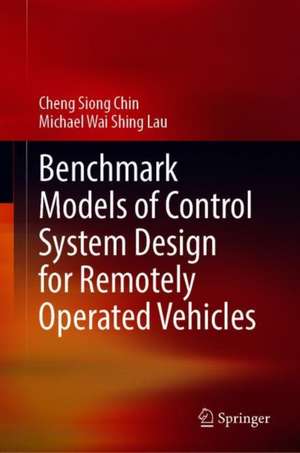Benchmark Models of Control System Design for Remotely Operated Vehicles
Autor Cheng Siong Chin, Michael Wai Shing Lauen Limba Engleză Hardback – 8 aug 2020
In this book, approaches such as WAMIT, ANSYS-CFX, STAR CCM+, MATLAB and Simulink are used to model parameters for ROVs. A few benchmark models are provided, allowing researchers and students to explore and test different control schemes. Given its scope, the book offers a valuable reference guide for postgraduate and undergraduate students engaged in modeling and simulation for ROV control.
| Toate formatele și edițiile | Preț | Express |
|---|---|---|
| Paperback (1) | 937.89 lei 6-8 săpt. | |
| Springer Nature Singapore – 9 aug 2021 | 937.89 lei 6-8 săpt. | |
| Hardback (1) | 943.73 lei 6-8 săpt. | |
| Springer Nature Singapore – 8 aug 2020 | 943.73 lei 6-8 săpt. |
Preț: 943.73 lei
Preț vechi: 1150.89 lei
-18% Nou
Puncte Express: 1416
Preț estimativ în valută:
180.59€ • 193.11$ • 150.57£
180.59€ • 193.11$ • 150.57£
Carte tipărită la comandă
Livrare economică 17 aprilie-01 mai
Preluare comenzi: 021 569.72.76
Specificații
ISBN-13: 9789811565106
ISBN-10: 9811565104
Ilustrații: XII, 140 p. 141 illus., 61 illus. in color.
Dimensiuni: 155 x 235 mm
Greutate: 0.4 kg
Ediția:1st ed. 2020
Editura: Springer Nature Singapore
Colecția Springer
Locul publicării:Singapore, Singapore
ISBN-10: 9811565104
Ilustrații: XII, 140 p. 141 illus., 61 illus. in color.
Dimensiuni: 155 x 235 mm
Greutate: 0.4 kg
Ediția:1st ed. 2020
Editura: Springer Nature Singapore
Colecția Springer
Locul publicării:Singapore, Singapore
Cuprins
Introduction.- Added Mass Computation for Control of An Open-Frame Remotely-Operated Vehicle: Application using WAMIT and MATLAB.- Modeling and Testing of Hydrodynamic Damping Model for a Complex-Shaped Remotely-Operated Vehicle for Control.- Robust and Decoupled Cascaded Control System of Underwater Robotic Vehicle for Stabilization and Pipeline Tracking.- Supervisory Cascaded Controllers Design: Experiment Test on a Remotely-Operated Vehicle.- Systematic Modeling and Model-based Simulation of a Remotely-Operated Vehicle using MATLAB and Simulink.- Experimental Validation of Open-Frame ROV model for Virtual Reality Simulation and Control.- Robust Genetic Algorithm and Fuzzy Inference Mechanism Embedded in Sliding-Mode Controller for Uncertain Underwater Robot
Notă biografică
Dr. Cheng Siong Chin is an Associate Professor at Newcastle University at Singapore where he has established research projects with vast industry partners from Seagate, ST-Electronics, Soil Machine Dynamics (SMD), SembCorp Marine, POSH, Visenti (Xylem), Temasek Polytechnic and Singapore Maritime Institute (SMI). He is also a Visiting Professor at Chongqing University. He has also supervised projects on the intelligent systems design and simulation of complex systems in uncertain environment. He has published over 100 journal papers, books, book chapters and conference papers. He is a Fellow of the Higher Education Academy, Fellow of IMarEST, senior member of IEEE and the IET, and a Chartered Engineer. He received the Best Paper Award for the Virtual Reality of Autonomous Vehicle in The 2018 10th International Conference on Modelling, Identification and Control sponsored by IEEE.
Dr. Michael Wai Shing Lau is an Associate Professor and a Degree Programme Director for Mechanical Design and Manufacturing Engineering at Newcastle University at Singapore. He has been involved in tertiary education in Singapore for more than 20 years. He has published more than 100 journal papers, book chapters and conference papers. His research activities include motion control, active vibration control, and design and control of mobile robotics including underwater vehicles.
Dr. Michael Wai Shing Lau is an Associate Professor and a Degree Programme Director for Mechanical Design and Manufacturing Engineering at Newcastle University at Singapore. He has been involved in tertiary education in Singapore for more than 20 years. He has published more than 100 journal papers, book chapters and conference papers. His research activities include motion control, active vibration control, and design and control of mobile robotics including underwater vehicles.
Textul de pe ultima copertă
This book is intended to meet the needs of those who seek to develop control systems for ROVs when there is no model available during the initial design stage. The modeling, simulation and application of marine vehicles like underwater robotic vehicles (URVs) are multidisciplinary, and combine mathematical aspects from various engineering disciplines. URVs such as remotely operated vehicle (ROVs) are used for a wide range of applications such as exploring the extreme depths of our ocean, where a hard-wired link is still required. Most ROVs operate in extreme environments with uncertainties in the model prior to control system design. However, the method involved extensive testing before the system model could be used for any control actions. It has been found that the range of error can be extensive and uncertain in actual, continuously varying conditions. Hence, it is important to address the problem of reliance on model testing using different modeling approaches.
In this book, approaches such as WAMIT, ANSYS-CFX, STAR CCM+, MATLAB and Simulink are used to model parameters for ROVs. A few benchmark models are provided, allowing researchers and students to explore and test different control schemes. Given its scope, the book offers a valuable reference guide for postgraduate and undergraduate students engaged in modeling and simulation for ROV control.
In this book, approaches such as WAMIT, ANSYS-CFX, STAR CCM+, MATLAB and Simulink are used to model parameters for ROVs. A few benchmark models are provided, allowing researchers and students to explore and test different control schemes. Given its scope, the book offers a valuable reference guide for postgraduate and undergraduate students engaged in modeling and simulation for ROV control.
Caracteristici
Includes benchmark models for ROV control system design Offers step-by-step guidance on the modeling of ROVs using various types of software: WAMIT, ANSYS-CFX, STAR CCM+, MATLAB and Simulink Easy to read and apply Explains how to model ROVs
